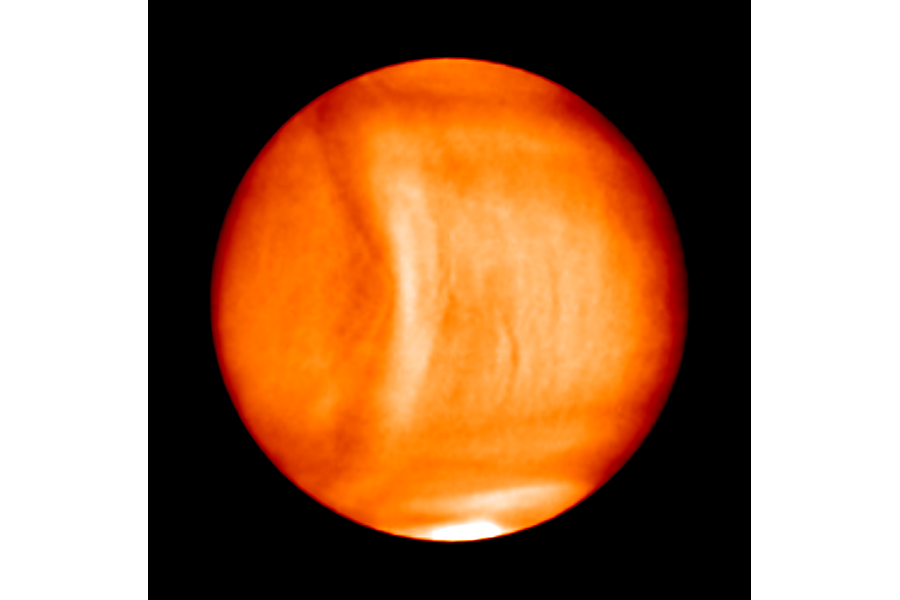 January 16, 2017
January 16, 2017
— Venus is blanketed in a thick layer of clouds that stretch 40 miles above the planet’s surface. This atmosphere shields the planet from view, making it difficult for astronomers to understand much about Earth’s neighbor. But an image captured by a Japanese spacecraft could help researchers unravel some of the mysteries of this enshrouded world.
When the Japan Aerospace Exploration Agency (JAXA)’s Akatsuki spacecraft arrived in orbit around Venus in December 2015 and started taking pictures of the planet, researchers noticed something strange going on in the cloud tops.
They really couldn’t have missed the bow-shaped feature that appeared in the longwave infrared images. Set against the fast-moving clouds of Venus’s upper atmosphere, the stationary feature stretched over 6,200 miles, practically from the planet’s north to south poles.
Researchers weren’t surprised to find such a disturbance in the planet’s atmosphere. Similar waves form in Earth’s own atmosphere. But deciphering this humongous structure could help yield clues into the mysterious planetary system that lies below the cloud tops of Venus.
The structure, described in a paper published Monday in the journal Nature Geoscience, is actually a massive gravity wave .
No, this is not the gravitational waves of Albert Einstein or LIGO lore formed from two huge, distant celestial bodies smashing into one another and rippling the fabric of spacetime. These waves form in the atmosphere of a planet when wind is flowing horizontally along the surface of the planet and comes to a mountain range, highlands, or some other obstruction and is forced to change direction, forced vertically, to flow over the surface feature. It’s like the water of a stream flowing over a rock, making a ripple, explains Colin Wilson, an atmospheric scientist at Oxford University who was not involved in the paper.
In this case, the Japanese researchers say, the bow-shaped wave lines up with Aphrodite Terra, a massive highland region near the equator of Venus.
Evidence of gravity waves has been spotted on Venus before, thanks to data from the European Space Agency’s Venus Express mission, which ended in 2015. And researchers have used radar data from NASA’s Magellan mission, which ended in 1994 to figure out just what topographical features might be causing those gravity waves. That radar data was able to pierce through the thick atmosphere of Venus to see down to the planet’s surface.
“[Venus Express] started to see some hints that the atmospheric wind pattern was slightly different over some of these highlands,” Dr. Wilson says in a phone interview with The Christian Science Monitor. “But because Venus Express had a different orbit where it got lots of images of the poles but not of the low latitudes, it never saw a feature like this. It never got these beautiful images which this Japanese spacecraft has now revealed. This is glorious. For those of us working on the Venus Express data, this is confirmation of a prediction which the data was suggesting from Venus Express. ”
What stood out to the Japanese researchers was the feature’s size and immobility.
“We have never seen such a huge thermal structure before, and the most surprising feature is that it stayed at an almost same geographical position for four days despite the background atmospheric super-rotation,” Makoto Taguchi of Rikkyo University in Tokyo, a coauthor of the study, writes in an email to the Monitor. “Y-shaped structures, which sometimes look like a bow, are always seen in the UV images and even seen in the middle infrared images of Venus, but they all moved with the background westward wind. ”
“Some researchers have imagined that a gravity wave excited in the lower atmosphere may reach the upper cloud deck or higher in the Venus atmosphere, but no direct evidence of that has been found before,” he says. “This is the first evidence of gravity wave propagation from the lower atmosphere to the middle atmosphere. This means that conditions of the lower atmosphere may affect the dynamics of the higher atmosphere by momentum transfer of the gravity waves. ”
As such, this may reveal that researchers can study the lower and middle atmosphere of Venus by looking at what is going on at the cloud tops. This would be a crucial clue as scientists continue trying understand Venus, despite not being able to penetrate the planet’s thick atmosphere with most imaging techniques. “It helps us to constrain a lot of the physics that’s going on in the deepest parts of the atmosphere, which we don’t have information on,” Constantine Tsang, a planetary scientist at the Southwest Research Institute in Boulder, Co. who was not involved in the research, says in a phone interview with the Monitor.
In their analysis of the bow-shaped structure, the researchers created a model of how a gravity wave might propagate from Aphrodite Terra up into the atmosphere.
“They used an atmosphere model (a bit like a weather model but for Venus), imposed a wave at 10 km in a region of mountains of Venus … and see what happens. Their wave propagated up in the atmosphere and at 65 km showed up as a feature which looked like what they had observed. So, chances are that the feature they see at 65 km is indeed generated by the mountains on Venus, transmitted into the atmosphere via these gravity waves,” Ingo Mueller-Wodarg, an atmospheric scientist at Imperial College London who was not involved in the research, writes in an email to the Monitor. That sounds all good, right?
Well actually, Dr. Mueller-Wodarg explains, gravity waves are often “dampened” in the atmosphere because of the wind structure. “So, to get it working in their model they had to assume a different wind structure than what is conventionally assumed for Venus, otherwise that feature wouldn’t have survived to the height of 65 km. Therefore, what we may learn from this is that the wind structure on Venus near the surface is different from what we previously thought. ”
Another mystery about Venus researchers hope to unravel is its atmosphere’s super rotation. While the planet takes 243 Earth days to spin on its axis just once, Venus’ atmosphere moves around the planet at speeds of about 450 miles an hour. That means if you were a balloon in Venus’ atmosphere, it would take you about 4 to 5 Earth days to circle the planet. So the atmosphere is moving very fast compared with the planet. The opposite is true on Earth, as the atmosphere rotates about every two weeks.
Home
United States
USA — Art What could that strange, humongous shape in Venus' atmosphere reveal about the...






